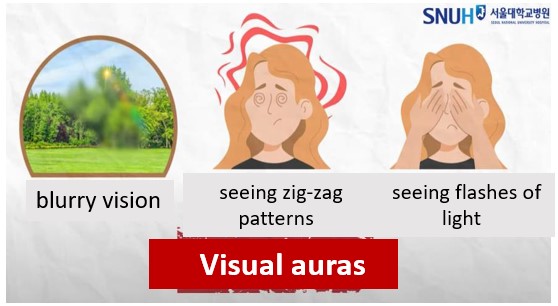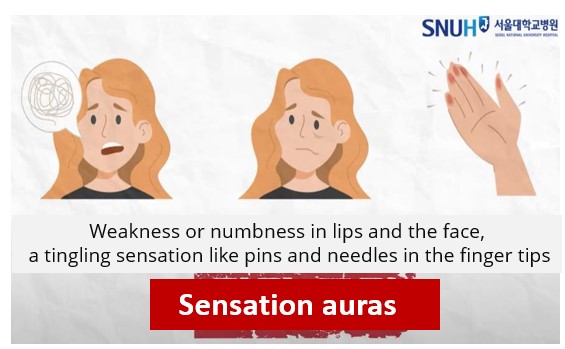Long-suffering ‘migraines’ that could be easily ignored
- Introduction to causes, treatment and prevention of migraine By Prof Lee Mi Ji from Department of Neurology, SNUH

[Picture] Prof Lee Mi Ji from Department of Neurology
Headaches are experienced by most people at least once in their lives, so many people do not think much of them. However, migraines of a severity that interferes with daily life constitutes a disease that should not be easily ignored.
Many people do not recognize migraines in particular as a disease, and so suffer for a long time or instead blame depression. Therefore, it is important to increase the understanding of migraines. Prof Lee Mi Ji from Seoul National University Hospital Neurology Department explains the cause, treatment, and prevention of migraine.
1. What is Migraine?
A migraine is commonly thought of as pain on one side of the head, but this is an incorrect definition. Diseases that cause headaches without a cause are called “primary headache disorders,” and the most important of the primary headache disorders are migraines.
If you have a headache that is severe enough to interfere with your daily life or work and lasts for more than half a day and gets better on its own within 3 days at the longest, it is likely to be a migraine. A migraine is characterized by throbbing pain, like a beating heart, but it is also common to manifest as a stabbing, pinching, or churning headache.
When you have a migraine, you may feel sick to your stomach or throw up, and you may be sensitive to light or sound. In addition, when a headache appears, even the slightest movement may lead to aggravation as if the brain is shaking, so there are many cases where patients must only lie down. Resultantly, when a migraine attack begins, it significantly interferes with daily normal life.
2. Is there a specific brain constitution that causes migraines?
It is known that there is a separate ‘migraine brain’ that is sensitive to environmental and body changes, and about 10 to 15% of the population is born with a brain that causes migraines. The migraine brain is more active than the normal brain. However, it does not behave abnormally; the brain constantly collects and processes information necessary for survival. In addition to this, while monitoring the external environment and the inside of the body, it quickly detects and responds to changes.
For example, even if we are not aware of it, if there are changes in the weather, seasons, temperature, humidity, etc., lights or sounds, smells, stressful situations, and irregular, insufficient or excessive living habits such as eating or sleeping, our body detects them quickly and triggers brain activity.
But, detecting and responding to these changes is not a hypersensitive reaction, but a normal survival response. However, in the case of migraine sufferers, these brain activities sometimes become hyperactive because they sense and respond to all signals without missing them.
When this hyperactivity of the brain occurs, an abnormal signal spreads in the brain, and the blood vessels and nerves of the meninges are activated in a complex manner, resulting in a headache.
3. The diagnosis of migraine
Basically, the diagnosis of a migraine is made through a medical questionnaire. Brain imaging may be needed to differentiate it from other causes of headaches. If you experience migraine headaches that significantly interfere with your daily life, and you have had five or more experiences that completely return to normal within 4 to 72 hours after you experience them, you likely suffer from migraines.
4. Migraine prodromal symptoms and aura
Migraine usually progresses in four stages: prodrome, aura, attack and post-drome.
Prodromal symptoms and auras before the onset of a headache are often helpful in diagnosis, so it is important to keep an eye on them. Prodromal symptoms include fatigue, lethargy, trouble concentrating, neck stiffness, changes in appetite, and irritability or changes of mood. These symptoms usually occur 2 to 48 hours before the onset of migraine and occur in about 80% of migraine sufferers.
Migraine aura is a symptom that occurs at the same time as or just before the onset of a migraine and includes blurred or shimmering zig-zag visual auras in part of the visual field, or weakness or numbness as well as pins and needle sensational auras in the lips and fingertips.


5. Treatment of migraine
For effective migraine treatment, both acute phase treatment and preventive treatment should be combined.
Acute phase treatment aims to stop or alleviate the headache and accompanying symptoms after the onset of the headache. Once a migraine begins, it is important to take an acute migraine medication as soon as possible for analgesic purposes, and to rest in order not make it worse.
Mild migraines can be treated with general pain relievers, but moderate or severe migraines require specialized treatment, such as Triptans, which constrict dilated cerebral blood vessels.
Recently, the 'Ditan drug' without a vasoconstrictor effect was released in Korea, and the 'Gepant (CGRP* antagonist) drug' has also been approved by the FDA and is actively used in the United States, and scheduled to be released in Korea.
*CGRP (calcitonin gene-related peptide): A neurotransmitter that causes migraines by dilating blood vessels and causing an inflammatory response.
In addition, neuromodulation treatment through electronic drugs, that is, medical devices, rather than ingestible drugs, is also possible in Korea. With so many treatment options for migraine, it is now possible to tailor a response to the needs of a variety of migraine sufferers.
However, care should be taken when using acute-phase medications for analgesia more than 10 times a month as they can lead to chronic headaches such as chronic migraine and medication overuse headaches.
If the frequency of headaches is too frequent or the intensity of headaches is so severe that acute-phase medications do not solve the problem, preventive treatment to reduce the frequency and intensity of headaches should be performed concurrently. Preventive treatment includes drugs such as antidepressants, antiepileptic drugs, beta-blockers, and calcium channel blockers.
Since these drugs are taken continuously for several months or longer and the therapeutic effect is observed, the effect may not be felt in a short period, so patients often make a hasty conclusion and stop taking the drug. Therefore, if possible, it is better to continue long-term treatment while consulting with the doctor in charge to increase the success rate of preventive treatment.
Meanwhile, Botox is sometimes used to treat a special subtype of migraine called chronic migraine. Botox is commonly known as an injection to improve wrinkles, but when Botox is injected in about 31 or more places in the muscles and nerves that cause migraines, the components of the Botox injection enter the nerve endings and block pain transmitters.
Recently, anti-CGRP antibody injections have been developed and are widely used at home and abroad. This injection has brought about a lot of changes in the migraine treatment paradigm as it has few side effects and is highly effective. It is one of the important treatment methods as it has been proven to be effective for intractable migraine headaches that have not seen alleviation with existing preventive treatments.
6. Lifestyle for migraine prevention
In addition to drug treatment, it is important to maintain a good balance by sleeping, waking up, eating, and exercising in a regular manner to maintain lifestyle habits to prevent migraines. In addition, it is good to avoid situations that cause hyperactivity of the brain, such as the consumption of caffeine or exposure to strong visual stimulation. Many migraine headaches can be prevented if you identify your migraine triggers and avoid those situations.
7. Advice to patients
“Inheriting a migraine-prone brain is not simply inheriting a disease, but also a type of helpful constitution that can be favorable to survival and achievement. However, if headaches caused by migraines occur frequently and afflict daily life, they constitute ‘headache disease’, which is considered an illness.
In Korea, there is a sentiment where people who complain of headaches are treated as sensitive or irritable people, and not only others but also those with headaches look at themselves with negatively, and in many cases, hide and tolerate their condition as much as possible.
However, when headaches become frequent and chronic, treatment becomes more difficult. There may also be cases that look like migraine headaches but actually indicate a dangerous lurking cause. Therefore, it is recommended that you actively receive accurate diagnosis and treatment of headaches through consultation with a neurologist.”